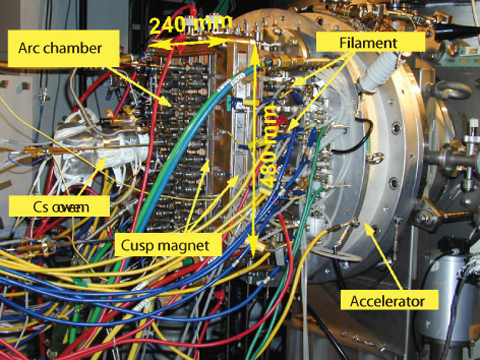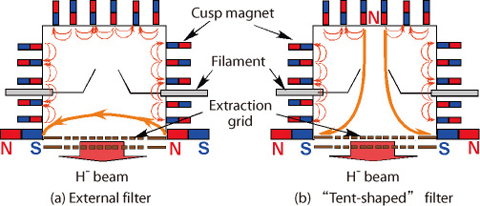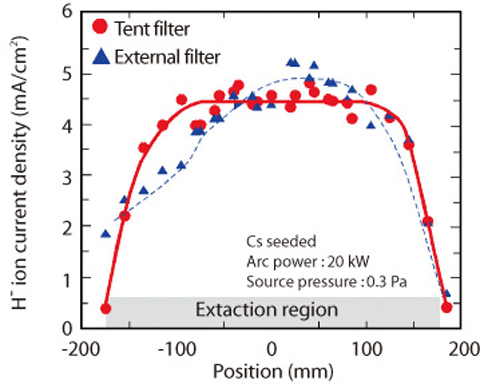
Fig.3-18 JAEA 10 A negative ion source

Fig.3-19 The magnetic configuration of 10 A negative ion source

Fig.3-20 The H- ion beam intensity
In a high energy neutral beam injection (NBI) system for fusion reactors, a large size negative ion source is required. However, in the negative ion source for a large fusion experimental reactor such as "JT-60U", non-uniformity of the extracted negative ion current density over the wide area of the source is observed. This causes poor optics of the beams and limits beam pulse length of the system, due to high heat loads placed on the acceleration grids and the beam line components.
To overcome this problem, experimental studies have been performed using the JAEA 10 A negative ion source whose magnetic configuration is similar to that of the large negative ion source of the JT-60 N-NBI (Fig.3-18).
In negative ion sources, hydrogen arc discharge produces dissociated H0 and/or H+. By seeding a small amount of Cesium (Cs) into the source, work function of the plasma grid is lowered, H0/H+ being converted to H- on the plasma grid surface (surface production). In the original H- source, a transverse magnetic field called a "magnetic filter" is formed to keep a low electron temperature around the extraction region (Fig.3-19 (a)). However, from the result of the 3D electron trajectory calculation, it was found that the residual magnetic filter field around the filament cathode causes a drift of the fast electrons emitted from the filaments. Due to this electron drift, the source plasma is localized and the ion beam becomes non-uniform.
Based on these results, the magnetic configuration of the JAEA 10 A negative ion source was modified in order to improve the beam uniformity. Instead of an external filter field, a tent-shaped filter field as shown in Fig.3-19(b) was employed between a cusp magnet on the source back plate and the large magnets placed outside of the aperture area of the plasma grid. This "tent filter" is effective to suppress co-extraction of electrons. Fig.3-20 shows the longitudinal beam profile before and after the modifications. The beam profile with the external filter configuration exhibited a non-uniform profile with the deviation of 16%. In the tent filter configuration, the uniformity of the extracted beam was drastically improved, the deviation of the beam profile reducing to 8%. The co-extracted electron current was suppressed to a level equivalent to that of the H- ion current.